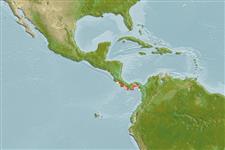>
Blenniiformes (Blennies) >
Chaenopsidae (Pike-, tube- and flagblennies)
Etymology: Mccoskerichthys: Because of John McCosker, ichthyologist and film diver + Greek, ichthys = fish.
Eponymy: Dr John Edward McCosker (d: 1945) is an ichthyologist and evolutionary biologist who is Senior Scientist and first Professor of Aquatic Research at California Academy of Sciences, San Francisco. [...] Sandra McCosker is an anthropologist and was the wife of ichthyologist John Edward McCosker (q.v.). She participated in the first collection of this species. (It might have been expected that the binomial would be sandrae, but the r is omitted) (Ref. 128868), visit book page.
More on authors: Rosenblatt & Stephens.
Environment: milieu / climate zone / depth range / distribution range
Écologie
marin démersal; profondeur 1 - 30 m (Ref. 11482). Tropical
Eastern Central Pacific: Costa Rica and Panama.
Taille / Poids / Âge
Maturity: Lm ? range ? - ? cm
Max length : 8.0 cm TL mâle / non sexé; (Ref. 11482)
Inhabits mollusk and worm tubes on near-vertical rock faces. Feeds on zooplankton, including copepods, amphipods, and ostracods.
Life cycle and mating behavior
Maturité | Reproduction | Frai | Œufs | Fécondité | Larves
Allen, G.R. and D.R. Robertson, 1994. Fishes of the tropical eastern Pacific. University of Hawaii Press, Honolulu. 332 p. (Ref. 11482)
Statut dans la liste rouge de l'IUCN (Ref. 130435: Version 2024-1)
Menace pour l'homme
Harmless
Utilisations par l'homme
Outils
Articles particuliers
Télécharger en XML
Sources Internet
Estimates based on models
Preferred temperature (Ref.
123201): 27.8 - 29.1, mean 28.5 °C (based on 96 cells).
Phylogenetic diversity index (Ref.
82804): PD
50 = 1.0000 [Uniqueness, from 0.5 = low to 2.0 = high].
Bayesian length-weight: a=0.00102 (0.00046 - 0.00225), b=3.06 (2.88 - 3.24), in cm total length, based on all LWR estimates for this body shape (Ref.
93245).
Niveau trophique (Ref.
69278): 3.3 ±0.45 se; based on food items.
Fishing Vulnerability (Ref.
59153): Low vulnerability (10 of 100).
Nutrients (Ref.
124155): Calcium = 394 [235, 811] mg/100g; Iron = 1.45 [0.87, 2.46] mg/100g; Protein = 17.4 [16.5, 18.3] %; Omega3 = 0.17 [0.09, 0.32] g/100g; Selenium = 36.5 [16.8, 79.4] μg/100g; VitaminA = 47.6 [15.8, 142.1] μg/100g; Zinc = 2.16 [1.50, 3.05] mg/100g (wet weight);
